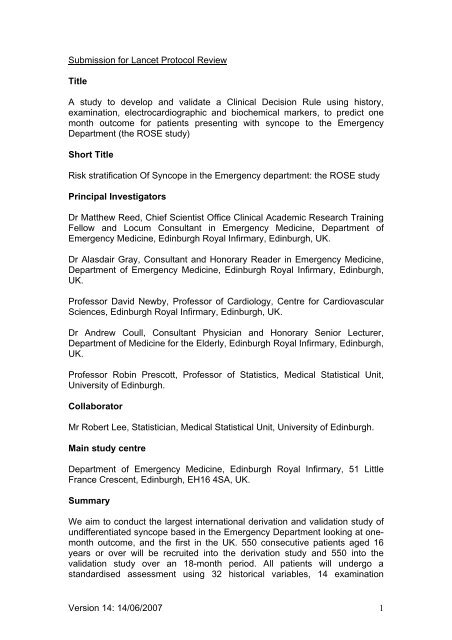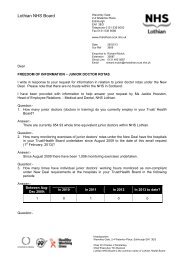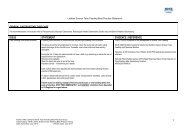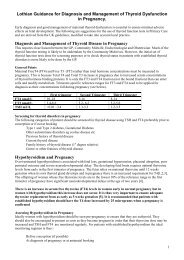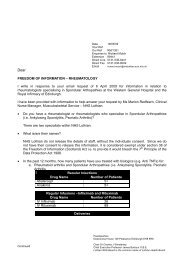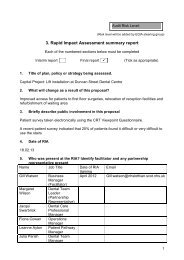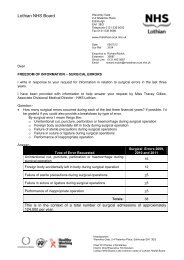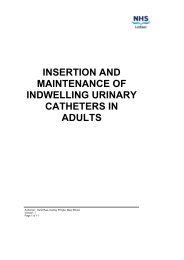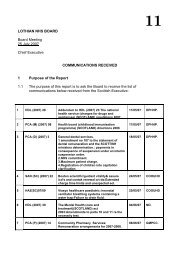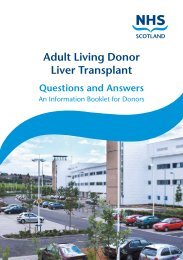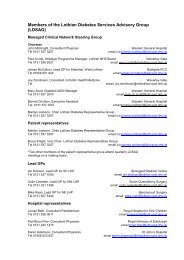Submission for Lancet Protocol Review Title A study ... - NHS Lothian
Submission for Lancet Protocol Review Title A study ... - NHS Lothian
Submission for Lancet Protocol Review Title A study ... - NHS Lothian
You also want an ePaper? Increase the reach of your titles
YUMPU automatically turns print PDFs into web optimized ePapers that Google loves.
<strong>Submission</strong> <strong>for</strong> <strong>Lancet</strong> <strong>Protocol</strong> <strong>Review</strong><br />
<strong>Title</strong><br />
A <strong>study</strong> to develop and validate a Clinical Decision Rule using history,<br />
examination, electrocardiographic and biochemical markers, to predict one<br />
month outcome <strong>for</strong> patients presenting with syncope to the Emergency<br />
Department (the ROSE <strong>study</strong>)<br />
Short <strong>Title</strong><br />
Risk stratification Of Syncope in the Emergency department: the ROSE <strong>study</strong><br />
Principal Investigators<br />
Dr Matthew Reed, Chief Scientist Office Clinical Academic Research Training<br />
Fellow and Locum Consultant in Emergency Medicine, Department of<br />
Emergency Medicine, Edinburgh Royal Infirmary, Edinburgh, UK.<br />
Dr Alasdair Gray, Consultant and Honorary Reader in Emergency Medicine,<br />
Department of Emergency Medicine, Edinburgh Royal Infirmary, Edinburgh,<br />
UK.<br />
Professor David Newby, Professor of Cardiology, Centre <strong>for</strong> Cardiovascular<br />
Sciences, Edinburgh Royal Infirmary, Edinburgh, UK.<br />
Dr Andrew Coull, Consultant Physician and Honorary Senior Lecturer,<br />
Department of Medicine <strong>for</strong> the Elderly, Edinburgh Royal Infirmary, Edinburgh,<br />
UK.<br />
Professor Robin Prescott, Professor of Statistics, Medical Statistical Unit,<br />
University of Edinburgh.<br />
Collaborator<br />
Mr Robert Lee, Statistician, Medical Statistical Unit, University of Edinburgh.<br />
Main <strong>study</strong> centre<br />
Department of Emergency Medicine, Edinburgh Royal Infirmary, 51 Little<br />
France Crescent, Edinburgh, EH16 4SA, UK.<br />
Summary<br />
We aim to conduct the largest international derivation and validation <strong>study</strong> of<br />
undifferentiated syncope based in the Emergency Department looking at onemonth<br />
outcome, and the first in the UK. 550 consecutive patients aged 16<br />
years or over will be recruited into the derivation <strong>study</strong> and 550 into the<br />
validation <strong>study</strong> over an 18-month period. All patients will undergo a<br />
standardised assessment using 32 historical variables, 14 examination<br />
Version 14: 14/06/2007 1
variables and 24 ECG based variables. All patients will also have a full blood<br />
count, urea, creatinine, liver function, glucose, electrolytes, high sensitivity<br />
CRP and near-patient BNP tests. Admitted patients and a random selection of<br />
100 discharged derivation group patients will undergo a <strong>for</strong>mal laboratory<br />
based Troponin I at least 12 hours post syncope. Endpoint measures are<br />
serious outcome at 1 month. A Clinical Decision Rule using history,<br />
examination, ECG, and biochemical markers will be developed and validated<br />
to predict 1 month outcome <strong>for</strong> patients presenting with syncope to the<br />
Emergency Department.<br />
Background and previous research<br />
Syncope is a transient loss of consciousness with an inability to maintain<br />
postural tone followed by a spontaneous recovery [1]. It accounts <strong>for</strong> 3% of<br />
ED visits and 1-6% of hospital medical admissions, affecting 6 per 1000<br />
people per year [2,3]. Clinical assessment of syncope is difficult due to the<br />
heterogeneous nature of underlying causes, ranging from benign<br />
neurocardiogenic syncope, to potentially fatal arrhythmias.<br />
In 1983, Kapoor et al [4] published the first prospective syncope <strong>study</strong>. 12month<br />
mortality was 14%. Mortality was greatest in patients in whom a<br />
cardiovascular cause was identified (30%). Subsequent studies have shown<br />
that underlying heart disease in patients with syncope is associated with a<br />
poor prognosis [5]. Recent emphasis has focused on risk stratification of<br />
patients with syncope. Although guidelines have been issued [6-10],<br />
evidence in respect to ED management is sparse.<br />
There are 5 risk stratification studies [11-16]. Most involved small numbers of<br />
patients and used different characteristics and outcome measures in their risk<br />
stratification tools. Only two were prospective and had mixed results [11,13].<br />
Only one <strong>study</strong>, a US based <strong>study</strong> looked at short-term adverse outcome<br />
[15,16], which is relevant to emergency medicine practice. There were two<br />
fundamental problems with this <strong>study</strong>. Firstly, two of the selected predictor<br />
variables included in the rule would usually necessitate immediate hospital<br />
admission (systolic blood pressure less than 90mmHg and a haematocrit of<br />
less than 30%). This greatly reduces the benefit of the rule in ED admission<br />
decision-making. Secondly, the rule was originally derived <strong>for</strong> 7 day serious<br />
outcome, however later validated <strong>for</strong> 1 month outcome. No studies have been<br />
examined in a UK population.<br />
With growing pressures on acute medical beds and an increasingly elderly<br />
population, there is a need <strong>for</strong> a large <strong>study</strong> of this common presenting<br />
symptom to identify high-risk populations requiring further investigation, and<br />
low-risk patients who may be discharged safely. Accurate identification of<br />
patients would enable specific targeting of resources and prevent excessive<br />
investigation of patients with benign causes.<br />
No risk stratification studies have investigated the role of biochemical markers<br />
in risk stratification. We hypothesize that Brain Natriuretic Peptide (BNP) and<br />
high sensitivity C-reactive protein (HS-CRP) acting as objective markers of<br />
underlying cardiac disease, may be excellent ED markers of 1 month<br />
outcome. BNP [17,18] is an excellent marker of prognosis in patients with<br />
heart failure or cardiac disease, and several prospective epidemiological<br />
studies from the United States and Europe have demonstrated that HS-CRP<br />
Version 14: 14/06/2007 2
is a good predictor of future coronary events [19-21]. It is also well<br />
established that prognosis in syncope is related to the presence of underlying<br />
heart disease [5], and all existing syncope CDRs include either a history of<br />
congestive heart failure [11,14,15] or underlying cardiac disease [12,13].<br />
Troponin I (TnI) is commonly measured 12 hours post syncope to rule out<br />
acute myocardial infarction (AMI) and has only been assessed as a<br />
prognostic marker in syncope in one previous <strong>study</strong> [22]. This <strong>study</strong> took<br />
Troponin levels as early as four hours after the syncopal episode, when<br />
sensitivity <strong>for</strong> AMI is poor (0.64) [23]. We hypothesize that a routine TnI is<br />
unnecessary and aim to assess the value of a 12-hour troponin as both an<br />
AMI rule-out marker, and as a syncope prognostic marker.<br />
Results of pilot <strong>study</strong><br />
A pilot <strong>study</strong> was per<strong>for</strong>med between November 2005 and January 2006. 99<br />
consecutive patients with undifferentiated syncope were enrolled (1.6 per<br />
day). 32 patients were high-risk, 51 medium and 16 low according to our<br />
existing departmental syncope guidelines (based on the European Society of<br />
Cardiology [9,10], American College of Physicians [6,7] and American<br />
College of Emergency Physicians guidelines [8]). 72 patients had BNP<br />
measured, 25 (35%) were 100 pg/ml or greater, and 3 were over 1000 pg/ml.<br />
44 patients were admitted to hospital and 55 were discharged from the ED. 30<br />
of those admitted had troponin I measured. Only one of these was raised<br />
(14.40 ng/ml) and this was thought to be due to an AMI. 66 patients had CRP<br />
measured, 16 were raised (>5 mg/l). There were 11 serious outcomes. 5<br />
patients had died by 3 months, and 6 others had an alternative serious<br />
outcome. 8 of the 11 patients had a serious outcome by 1 week. The<br />
percentage risk of serious outcome at 7 days, 1 month and 3 months was<br />
there<strong>for</strong>e 8.1%, 8.1% and 11.1% respectively. 9 of 11 serious outcome<br />
patients had BNP measured, 6 were >100, 3 were >1000 and all patients with<br />
a BNP >1000 were in the serious outcome group (2 died, 1 AMI) [24]. The<br />
OESIL score, the SFSR and our existing departmental guidelines all showed<br />
some ability to risk stratify syncope patients [25].<br />
Primary aim<br />
To develop and validate a Clinical Decision Rule (CDR) using history,<br />
examination, electrocardiographic (ECG) and biochemical markers, to predict<br />
one month outcome <strong>for</strong> patients presenting with syncope to the ED.<br />
Research questions<br />
(1) Can a syncope CDR using specific components from the history and<br />
examination, ECG characteristics and biochemical markers (HS-CRP and<br />
BNP) predict one-month outcome in ED patients presenting with syncope?<br />
(2) Can HS-CRP or BNP predict one-month outcome in patients presenting to<br />
the ED with syncope?<br />
Version 14: 14/06/2007 3
(3) Are biochemical markers in isolation better than history, examination and<br />
ECG characteristics at predicting one-month outcome, or are they more useful<br />
in conjunction with them to improve the accuracy of a CDR in predicting onemonth<br />
outcome in syncope patients presenting to the ED?<br />
(4) How does the validation of this CDR compare with the validation of<br />
existing ED syncope CDRs in the UK ED population?<br />
(5) Is it necessary to measure a 12-hour troponin I level in all patients<br />
presenting to the ED with syncope?<br />
Methods: Setting<br />
The ED of the Royal Infirmary of Edinburgh (85,000 adult attendances per<br />
annum).<br />
Target population<br />
From the pilot <strong>study</strong> it was estimated that there are 1200 patients presenting<br />
to our ED per annum who are eligible <strong>for</strong> enrolment into the <strong>study</strong>. With an<br />
improved recruitment strategy we aim to recruit between 800 and 1000<br />
patients per annum.<br />
Sample size calculation and statistical power<br />
Statistical advice was sought early during planning of the pilot and main <strong>study</strong>.<br />
With a sample size of 500 patients, if the one month adverse outcome rate is<br />
10.0% [15,25] at the average value of any predictor variable, then there will<br />
be 80% power of showing that this variable has a statistically significant effect<br />
on ‘serious outcome’ (p
Exclusion criteria<br />
� Patients under 16<br />
� Patients previously recruited<br />
� Patient with a good history of seizure or a prolonged (>15 minutes)<br />
post-ictal phase<br />
� Patients who are unable to give written or verbal consent and who do<br />
not have a relative or guardian to give written assent<br />
� Patients whose collapse is suspected to be due entirely to excessive<br />
alcohol consumption<br />
� Suspected alcoholic/epileptic seizure<br />
� Near-syncope (i.e. no loss of consciousness)<br />
Enrolment into derivation <strong>study</strong><br />
Eligible patients will be flagged at the ED high dependency triage area and a<br />
data collection <strong>for</strong>m (DCF) will be placed in the patient’s records. Assessment<br />
of patients will be carried out by routine ED medical staff who will also be<br />
responsible <strong>for</strong> deciding eligibility. A decision to enrol a patient will not be later<br />
overturned by the <strong>study</strong> team and enrolled patients will be analysed on an<br />
intention to treat basis.<br />
Because the treating doctor is enrolling eligible patients and completing the<br />
data collection <strong>for</strong>m there is theoretically a possible selection bias. Sicker<br />
patients may be excluded because of the time required to complete <strong>study</strong><br />
paperwork. This has been addressed by reducing the paperwork required to<br />
be completed at the time of enrolment to an absolute minimum. The <strong>study</strong><br />
researcher (MR) will complete the rest of the data collection i.e. blood results<br />
at a later time. The treating doctor should complete as much as possible of<br />
the DCF at the time of patient enrolment. If <strong>for</strong> some reason in<strong>for</strong>mation is not<br />
available they should leave the appropriate part of the <strong>for</strong>m blank. The <strong>study</strong><br />
researcher (MR) will review the data collected in the ED and will document<br />
any further in<strong>for</strong>mation that becomes available later. Data obtained after the<br />
patient’s ED attendance will be marked as retrospectively obtained data <strong>for</strong><br />
the purposes of analysis in both the DCF and also in the <strong>study</strong> database. It is<br />
important that any derived CDR is based on in<strong>for</strong>mation that is available to the<br />
ED doctor at the time of seeing a patient. It is also important <strong>for</strong> a CDR to<br />
have as accurate in<strong>for</strong>mation as possible and there<strong>for</strong>e the end analysis will<br />
include the opportunity to look at this retrospectively available in<strong>for</strong>mation.<br />
We aim to have a minimum of 500 patients in the derivation cohort available<br />
<strong>for</strong> final analysis. Because there will be some patients that are lost to followup,<br />
inevitably some <strong>for</strong> whom all data is not obtained, and a small proportion<br />
who will be excluded later due to them having an obvious cause necessitating<br />
admission on presentation to the ED, we will aim to recruit 550 patients during<br />
the 9 month derivation <strong>study</strong>.<br />
Version 14: 14/06/2007 5
Assessment<br />
All patients will undergo a standardised assessment using 32 pre-determined<br />
variables (9 focussed on clinical features, 10 on past medical history and 13<br />
concerning current medication) and 14 examination variables. These were<br />
selected after careful systematic review of the literature to identify<br />
characteristics that have previously been shown to be associated with serious<br />
outcome.<br />
After a full history and examination, all patients will undergo a 12-lead ECG,<br />
lying standing blood pressures and a ‘BM stix’ glucose estimation. All patients<br />
will have two red (2.7ml EDTA KE), one orange (4.7ml Lithium-Heparin-Gel)<br />
and one yellow tube (2.7ml Glucose FE) taken and a full blood count, urea,<br />
creatinine, glucose, electrolytes, liver function and HS-CRP will be <strong>for</strong>mally<br />
measured in the hospital laboratory. One green tube (3ml Coagulation 9 NC)<br />
will also be taken, spun down in the biochemistry laboratory and the plasma<br />
kept <strong>for</strong> storage. A <strong>study</strong> label will be placed onto the laboratory request <strong>for</strong>m,<br />
and samples will be sent to the hospital laboratory in the usual manner.<br />
Near-patient BNP testing will be per<strong>for</strong>med using a small quantity of blood<br />
from the other ‘spare’ red (2.7ml EDTA KE) tube using the Biosite Triage®<br />
point of care machine. For any patient in whom the near-patient BNP test has<br />
not been per<strong>for</strong>med (i.e. physician or machine error) this will be per<strong>for</strong>med the<br />
following day using the serum from the patient’s original EDTA sample, which<br />
was taken on the patient’s presentation. This will have been spun down after<br />
testing and stored immediately in the fridge in the biochemistry department.<br />
Treating physicians will not be blinded to the result of the BNP test.<br />
All admitted patients will have a laboratory based Troponin I at least 12 hours<br />
post syncope per<strong>for</strong>med by the admitting team, by the <strong>study</strong> researcher (MR)<br />
or added onto an existing sample in the laboratory which has been taken<br />
between 12 hours and 7 days after the syncopal episode. Patients still in the<br />
ED at 12 hours post ED arrival will be defined as admitted.<br />
A consecutive cohort of 100 derivation <strong>study</strong> patients who were discharged<br />
from the ED will be selected to return <strong>for</strong> an interval Troponin I. The patients<br />
will return to the Clinical Research Facility of the Royal Infirmary of Edinburgh<br />
to a special clinic run by one of the facility’s research nurses. Patients will be<br />
given standard travelling expenses of £30. The troponin test will be per<strong>for</strong>med<br />
as soon as possible after ED discharge but no later than 7 days and no<br />
sooner than 12 hours after the episode of syncope. Troponin levels
After <strong>for</strong>mal routine laboratory testing the red (2.7ml EDTA KE), orange (4.7ml<br />
Lithium-Heparin-Gel), yellow (2.7ml Glucose FE) and green tubes (3ml<br />
Coagulation 9 NC) <strong>for</strong> all enrolled patients will be spun down, separated and<br />
stored initially in a refrigerator in the biochemistry laboratory. The samples<br />
will then be frozen at minus 20 degrees Celsius. Once a week, the previous<br />
week’s samples will be thawed and divided into smaller aliquots and refrozen<br />
at minus 80 degrees Celsius <strong>for</strong> further analysis (which will include Vidas D-<br />
Dimer and markers inflammation and ischemia) at a later date. These frozen<br />
samples will be stored initially in a research freezer in the ED and later in the<br />
Centre <strong>for</strong> Inflammation Research, Queen’s building, University of Edinburgh<br />
under the supervision of Dr Matthew Reed, <strong>for</strong> an indefinite period.<br />
In order to quantify the number of eligible patients not being enrolled into the<br />
<strong>study</strong>, a daily search of all ED electronic patient records (EPRs) will<br />
conducted throughout the <strong>study</strong> using Microsoft Business Objects® looking<br />
<strong>for</strong> the keywords 'syncope', 'collapse', 'faint', 'loss of consciousness' or 'loc'<br />
appearing anywhere on the EPR. All EPRs with one of these terms will then<br />
be hand searched and a decision made from the notes about whether a<br />
patient presented with a possible syncopal event and whether or not they<br />
were eligible <strong>for</strong> enrolment. Out of those eligible <strong>for</strong> enrolment, it will be<br />
established how many were successfully enrolled and how many were missed<br />
and <strong>for</strong> what reason (i.e. missed by doctor, refused consent, consent not able<br />
to be obtained). A database will be compiled of those patients who were<br />
eligible but who were not enrolled along their demographic details and at the<br />
conclusion of the derivation stage, these will be compared to those patients<br />
who are recruited into the <strong>study</strong> and statistical analysis will be per<strong>for</strong>med.<br />
A Microsoft Access® database has been designed <strong>for</strong> data entry, which will<br />
be per<strong>for</strong>med by MR. A separate database will be used <strong>for</strong> derivation and<br />
validation cohorts. A second researcher will check a random selection of 100<br />
patient data collection <strong>for</strong>ms from the derivation <strong>study</strong> in order to ensure<br />
accuracy of data entry. If errors are found, this check will be extended to the<br />
entire database. The contents of the Microsoft Access® database will be<br />
exported into Microsoft Excel®, SPSS and SAS <strong>for</strong> statistical analysis. A<br />
patient flow chart will be constructed detailing patient recruitment.<br />
Endpoint measures<br />
Primary outcome: Serious outcome or all cause death at one month<br />
Definition of serious outcome:<br />
� AMI (history of chest pain or ECG changes and troponin I>0.2),<br />
� Life-threatening arrhythmia (as defined prior by expert panel - recorded<br />
episode of VF, sustained VT, ventricular pause greater than 3 seconds,<br />
Mobitz type 2, Wenkebach, bifascicular or complete heart block, or<br />
symptomatic bradycardia
� Insertion of Pacemaker or Internal Cardiac Defibrillator device or a<br />
decision that the patient requires such a device, within 1 month of the<br />
ED attendance.<br />
� Pulmonary embolus (confirmed on VQ/CTPA and requiring treatment),<br />
� Cerebrovascular accident/subarachnoid haemorrhage (CT or LP<br />
diagnosis),<br />
� Haemorrhage requiring a blood transfusion of two units or more during<br />
inpatient stay, and an acute surgical procedure or endoscopic<br />
intervention secondary to a suspected cause of syncope.<br />
As part of the data analysis process, two researchers from the expert panel<br />
will independently review notes of all patients who are considered to have<br />
reached endpoint in order to independently agree this. These experts will be<br />
blinded to the presence or absence of all predictor variables.<br />
Secondary outcome: Syncope related death (death due to a recognised<br />
cause of syncope as decided by the expert panel)<br />
Outcome, final discharge diagnosis and in<strong>for</strong>mation regarding inpatient stay,<br />
investigations, interventions and serious outcome will be identified by way of<br />
ED, hospital, ISD, Registrar General and GP records, death certificates and<br />
post mortem results, and via a structured telephone interview with the patient.<br />
Endpoint review<br />
� An expert committee will be convened to review all patients who are<br />
suspected of having a primary outcome to determine agreement.<br />
� All patients whose cause of syncope was known to the treating ED<br />
physician at the time of enrolment and whose underlying cause<br />
necessitated admission will be removed from the final analysis after<br />
expert committee review:<br />
o Suspected AAA rupture with SBP < 90mmHg,<br />
o AMI - chest pain with ST elevation >1mm in any lead,<br />
o Severe onset of headache with CT or LP diagnosis of SAH in<br />
ED,<br />
o Recorded episode of VF, sustained VT, CHB or symptomatic<br />
bradycardia
Statistical analysis<br />
After derivation data collection, multivariate logistical regression analysis will<br />
be per<strong>for</strong>med to determine factors associated with the endpoints, and a CDR<br />
will be developed. Previous syncope risk stratification models have either<br />
used a stepwise multiple linear logistic regression model, a stepwise Cox<br />
proportion hazards model or recursive partitioning. The stepwise procedures<br />
can be criticised because they are automatic methods, based on the<br />
independent statistical significance of the potential risk factors. Thus a<br />
relevant variable may be excluded if it has a moderate correlation with a<br />
variable already in the model. Conversely, the large number of risk factors<br />
considered also raises issues of multiple testing and the possibility of<br />
detecting false positive associations. Recursive partitioning has an even<br />
greater risk from false positive findings as the method, in effect, allows <strong>for</strong><br />
complex interactions among the potential risk factors. Our approach will utilise<br />
multiple linear logistic regression but model development will not be<br />
automatic.<br />
In a preliminary stage of analysis, we will attempt to reduce the number of<br />
variables using principal component analysis to identify ‘factors’ among the<br />
set of contender variables. Thus variables that tend to be mutually correlated<br />
will be combined into single variables. Subsequent logistic regression<br />
modelling will take a knowledge-based approach, incorporating widely<br />
accepted risk factors regardless of their statistical significance, while requiring<br />
a high level of significance <strong>for</strong> variables that other studies have found to be<br />
unimportant. The biochemical markers will be assessed primarily on their<br />
ability to add value to the risk stratification based on conventional risk factors,<br />
but their effects will also be assessed univariately.<br />
Troponin will be analysed in admitted patients and in 100 consecutive<br />
discharged derivation cohort patients. Troponin I will not be included as a<br />
predictor variable <strong>for</strong> the purposes of the derivation of the CDR due to the<br />
result not being available to the admitting doctor at the time of ED decision<br />
making.<br />
Models will be developed <strong>for</strong> all of the main outcome variables, from which<br />
practical CDRs will be <strong>for</strong>mulated. The subjective elements in the model<br />
derivation make it particularly important that the models are validated<br />
independently.<br />
The validation dataset will be obtained while the deviation dataset is being<br />
analysed, and no data from it will be released until the CDR has been<br />
finalised. The prospective data collection in this <strong>study</strong> should minimise the<br />
amount of missing data, but <strong>for</strong> model development, analysis of all subjects is<br />
important. For any categorical variables ‘missing’ will be considered as a<br />
category, while <strong>for</strong> continuous variables mean imputation will be used in<br />
conjunction with a binary dummy variable to indicate whether or not the<br />
numerical variable has been imputed.<br />
Prospective validation<br />
We aim to have 500 patients available <strong>for</strong> final analysis and there<strong>for</strong>e we will<br />
aim <strong>for</strong> 550 to be recruited as above in an attempt to validate the developed<br />
CDR. Statistical analysis will be used to assess the CDR per<strong>for</strong>mance.<br />
Version 14: 14/06/2007 9
A separate further <strong>study</strong> is planned that will assess the impact of using the<br />
CDR on admission rate, outpatient follow-up rate and detection of serious<br />
outcomes. A separate cost benefit analysis <strong>study</strong> will also be per<strong>for</strong>med.<br />
Ethics Committee approval<br />
This <strong>study</strong> received full ethical approval from the MREC <strong>for</strong> Scotland A Ethics<br />
committee (Reference: 06/MRE00/107) and <strong>Lothian</strong> REC (Reference:<br />
06/S11ADMIN/151) on January 8 th 2007, and a submitted substantial<br />
amendment was approved on 22 nd February 2007. <strong>Lothian</strong> R&D<br />
management approval was also obtained on 24 th January 2007 (Reference:<br />
2006/R/AE/03).<br />
In<strong>for</strong>med consent and in<strong>for</strong>mation sheet<br />
MREC approval has been obtained <strong>for</strong> the <strong>study</strong> Patient In<strong>for</strong>mation Sheet,<br />
Patient In<strong>for</strong>mation Sheet <strong>for</strong> Relatives, Patient Consent Form, Patient<br />
Consent Form <strong>for</strong> Relatives and GP In<strong>for</strong>mation Sheet.<br />
Dissemination<br />
It is anticipated that the <strong>study</strong> results will be submitted <strong>for</strong> to a internationally<br />
renown peer reviewed journal and presented at both national and international<br />
meetings and conferences.<br />
Sponsor<br />
Chief Scientist Office of the Scottish Executive (Reference No: CSO/CAF/01)<br />
Start date (recruitment): March 2007<br />
Finish Date (18 months recruitment): July 2008<br />
Finish Date (1 month follow up): August 2008<br />
Expected Reporting Date: November 2008<br />
Version 14: 14/06/2007 10
Key references<br />
1. Morag R. Syncope. In: Peak DA, Talavera F, Halamka J, et al.<br />
eMedicine on line Emergency textbook.<br />
www.emedicine.com/emerg/topic876.htm<br />
2. Maisel WH, Stevenson WG. Syncope: getting to the heart of the<br />
matter. N Engl J Med 2002; 347: 931-933.<br />
3. Soteriades ES, Evans JC, Larson MG, et al. Incidence and prognosis<br />
of syncope. N Engl J Med 2002; 347: 878-885.<br />
4. Kapoor WN, Karpf M, Wieand S, et al. A prospective evaluation and<br />
follow-up of patients with syncope. N Engl J Med 1983; 309: 197-204.<br />
5. Kapoor WN, Hanasu BH. Is Syncope a Risk Factor <strong>for</strong> Poor<br />
Outcomes? Comparison of Patients With and Without Syncope. Am J<br />
Med. 1996; 100: 646-655.<br />
6. Linzer M, Yang EH, Estes NA III, Wang P, Vorperian VR, Kapoor WN.<br />
Diagnosing syncope. 1. Value of history, physical examination, and<br />
electrocardiography: Clinical Efficacy Assessment Project of the<br />
American College of Physicians. Ann Intern Med 1997; 126: 989-96.<br />
7. Idem. Diagnosing syncope. 2. Unexplained syncope: Clinical Efficacy<br />
Assessment Project of the American College of Physicians. Ann Intern<br />
Med 1997; 127: 76-86.<br />
8. Molzen GW, Suter RE, Whitson R. American College of Emergency<br />
Physicians: Clinical Policy: critical issues in the evaluation and<br />
management of patients presenting with syncope. Ann Emerg Med.<br />
2001; 37: 771-776.<br />
9. Brignole M, Alboni P, Benditt DG, et al. Task Force on Syncope,<br />
European Society of Cardiology. Guidelines on management<br />
(diagnosis and treatment) of syncope-update 2004. Executive<br />
Summary. European Heart Journal. 2004; 25(22): 2054-72.<br />
10. Brignole M, Alboni P, Benditt D, et al. Task Force on Syncope,<br />
European Society of Cardiology. Guidelines on management<br />
(diagnosis and treatment) of syncope. European Heart Journal 2001;<br />
22(15): 1256-306.<br />
11. Martin GJ, Adams SL, Martin HG, Mathews J, Zull D, Scanlon PJ.<br />
Prospective evaluation of syncope. Ann Emerg Med 1984; 13: 499-<br />
504.<br />
12. Oh JH, Hanusa BH, Kapoor WN, et al. Do Symptoms Predict Cardiac<br />
Arrhythmias and Mortality in Patients With Syncope? Arch Intern<br />
Med. 1999; 159: 375-380.<br />
13. Colivicchi F, Ammirati F, Melina D, et al. Development and prospective<br />
validation of a risk stratification system <strong>for</strong> patients with syncope in the<br />
emergency department: the OESIL risk score. European heart journal<br />
2003; 24: 811-819.<br />
14. Sarasin FP, Hanusa BH, Perneger T, et al. A Risk Score to Predict<br />
Arrhythmias in Patients with Unexplained Syncope. Acad Emerg Med.<br />
2003; 10(12): 1312-1317.<br />
15. Quinn JV, Stiell IG, McDermott DA, et al. Derivation of the San<br />
Francisco Syncope Rule to Predict Patients With Short-Term Serious<br />
Outcomes. Ann Emerg Med. Feb 2004; 43: 224-232.<br />
Version 14: 14/06/2007 11
16. Quinn JV, McDermott DA, Stiell IG, et al. Prospective Validation of the<br />
San Francisco Syncope Rule to Predict Patients With Serious<br />
Outcomes. Ann Emerg Med. May 2006; 47: 448-453.<br />
17. Doust JA, Glasziou PP, Pietrzak E, et al. A systematic review of the<br />
diagnostic accuracy of natriuretic peptides <strong>for</strong> heart failure. Arch Intern<br />
Med 2004; 164: 1978-84.<br />
18. Doust JA, Pietrzak E, Dobson A, et al. How well does B-type<br />
natriuretic peptide predict death and cardiac events in patients with<br />
heart failure: systematic review. BMJ 2005; 330: 625-627.<br />
19. Alonso-Martinez JL, Llorente-Diez B, Echegaray-Agara M, et al. Creactive<br />
protein as a predictor of improvement and readmission in heart<br />
failure. European Journal of Heart Failure 2002; 4(3): 331-6.<br />
20. Ridker PM, Cushman M, Stampfer MJ, et al. Inflammation, aspirin, and<br />
the risk of cardiovascular disease in apparently healthy men. New<br />
England Journal of Medicine 1997; 336(14): 973-9.<br />
21. Koenig W, Sund M, Frohlich M, et al. C-Reactive protein, a sensitive<br />
marker of inflammation, predicts future risk of coronary heart disease in<br />
initially healthy middle-aged men: results from the MONICA (Monitoring<br />
Trends and Determinants in Cardiovascular Disease) Augsburg Cohort<br />
Study, 1984 to 1992. Circulation 1999; 99: 237–42.<br />
22. Hing R. Harris R. Relative utility of serum troponin and the OESIL<br />
score in syncope. Emergency Medicine Australasia 2005; 17(1): 31-38.<br />
23. Ebell MH, White LL, Weismantel D. A systematic review of troponin T<br />
and I values as a prognostic tool <strong>for</strong> patients with chest pain. J Fam.<br />
Pract. 2000; 49: 550-6.<br />
24. Reed MJ, Newby DE, Coull AJ, Jacques KG, Prescott RJ, Gray AJ.<br />
Near-patient BNP is able to predict three-month serious outcome in<br />
adult syncope patients presenting to the Emergency Department. (in<br />
press)<br />
25. Reed MJ, Newby DE, Coull AJ, Jacques KG, Prescott RJ, Gray AJ.<br />
The Risk stratification Of Syncope in the Emergency department<br />
(ROSE) pilot <strong>study</strong>: a comparison of existing syncope guidelines.<br />
Emerg Med J 2007; 24: 270-275.<br />
Version 14: 14/06/2007 12


